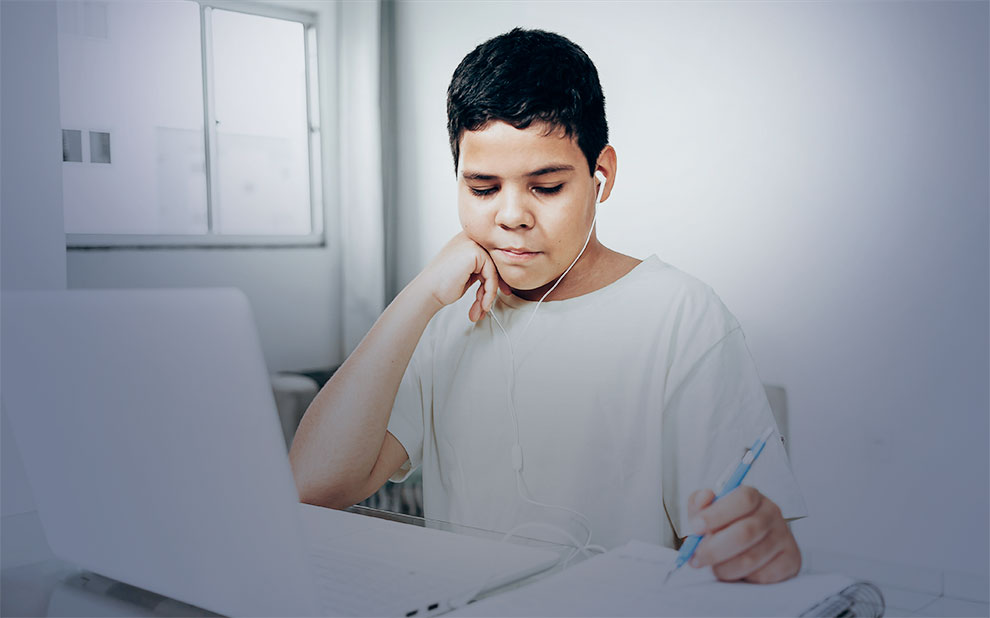Education may regress up to four years due to pandemic, according to study
Based on data from Brazil’s Basic Education Assessment System (SAEB), it was found that the country regressed to its level of proficiency recorded in an assessment four years ago (between 2015 and 2017) in Portuguese and three years ago in mathematics (2017) in terms of final elementary school grades, considering the worst-case scenario

In 2020, education was hit hard by the COVID-19 pandemic. As schools closed, millions of Brazilian children and teenagers had their face-to-face classes halted more than eight months ago – one the longest periods in comparison with other countries. To understand the consequences of this crisis, the Lemann Foundation commissioned a study from the Center for Learning in Evaluation and Results for Brazil and Portuguese-Speaking Africa (FGV EESP Clear), part of Fundação Getulio Vargas (FGV), to simulate the loss of learning that students may have experienced because of the novel coronavirus pandemic. The result shows that in 2020, students’ progress suffered more in mathematics than in Portuguese, and in most cases elementary school students were the worst affected.
Based on data from Brazil’s Basic Education Assessment System (SAEB), it was found that the country regressed to its level of proficiency recorded in an assessment four years ago (between 2015 and 2017) in Portuguese and three years ago in mathematics (2017) in terms of final elementary school grades, considering the worst-case scenario. In an intermediate simulation, both subjects returned to their levels of three years ago. Even in an optimistic scenario, education may also have lost three years in Portuguese.
The number of hours dedicated to non-face-to-face activities can make a difference: in an intermediate scenario, considering that students learn in non-face-to-face education in proportion to the hours dedicated to school activities, students in the final years of elementary school lost 34%, while high school students lost 33%. If a pessimistic scenario is considered, in which students learn nothing from remote teaching, both cycles lost the equivalent of 72% in learning.
“The simulation shows our reliance on remote education, despite all its limitations. Technology has proved to be an ally in the teaching and learning process during the pandemic, and hybrid education will continue to be fundamental in 2021, including in the process of overcoming gaps,” says Daniel de Bonis, the Lemann Foundation’s education policy director.
To obtain these results, the FGV EESP Clear study took into account the level of learning in a typical year (using data from SAEB from 2015 to 2019), the period of lost classes (estimated to be 72% of the school year) and potential learning from remote education (in optimistic, intermediate and pessimistic scenarios). The methodology was based on a World Bank study called “Simulating the potential impacts of COVID-19 school closures on schooling and learning outcome: a set of global estimates.”
“The aim of our work was to understand and establish some reasonable conjectures on how the COVID-19 pandemic could affect the learning of Brazilian students. First, by systematically reviewing the international literature, we concluded that stopping classes leads to a significant reduction in student learning. Second, we found that in a scenario of cancelled face-to-face classes, students’ learning depends on access to remote education and access is uneven in Brazil, as evidenced by data from the PNAD COVID-19 survey. Finally, analyzing SAEB data, we concluded that in 2020, Brazilian students’ learning may have slowed down or even regressed. This happened unevenly across the country, affecting the least favored most strongly. Thus, we urgently need efforts to mitigate this loss and guarantee access to high-quality remote education for all, in order to avoid this loss of learning and increase in educational inequalities,” says André Portela, the study’s lead researcher and professor of public policies at Fundação Getulio Vargas’ Sao Paulo School of Economics (FGV EESP).
Inequality
The researchers’ simulations also took into account students’ personal details: gender, race/color and mother’s level of education. Based on these subgroups, analyzing only the intermediate scenario, it was estimated that boys learned less than girls, especially in mathematics in the final years of elementary school.
The worst affected population groups in the final years of elementary school (fifth to ninth grade) and high school, in both subjects, were boys, children with brown or black skin, indigenous children, and children whose mother did not complete elementary school. In most cases, the least affected were girls, children who describe themselves as white, and children whose mother completed high school.
Inequalities also appear across different Brazilian states. In both elementary school and high school, students in the North and Northeast regions stopped learning more than students from the South and Southeast regions.
Diagnostic assessment and curriculum flexibility
The inequality between groups of students, subjects, school cycles and regions, as identified in the study, poses a challenge for school networks in planning face-to-face classes. “Measuring the level at which each student is, based on diagnostic assessments, will be necessary in this context of uncertainty, as students’ access to remote education has been very uneven,” says de Bonis. “Identifying these gaps will enable a flexible approach to content, focused on what each student needs to recover lost learning.”
To support education networks across Brazil at this stage, the Learning Support Platform was recently launched. It provides tools for the application of diagnostic assessments. Learning verification activities are available free of charge to teachers and school managers. Based on this assessment, the platform assists with the construction of effective lesson plans, anchored in the National Curriculum and a set of guidelines so that all students can advance through the content. The platform was designed by Consed and Undime, through the Frente de Avaliação, with the support of the Inter-American Development Bank, CAEd/UFJF, the Lemann Foundation, the Roberto Marinho Foundation, the Ayrton Senna Institute, the Reúna Institute and the Itaú Social Foundation.
Leia também
